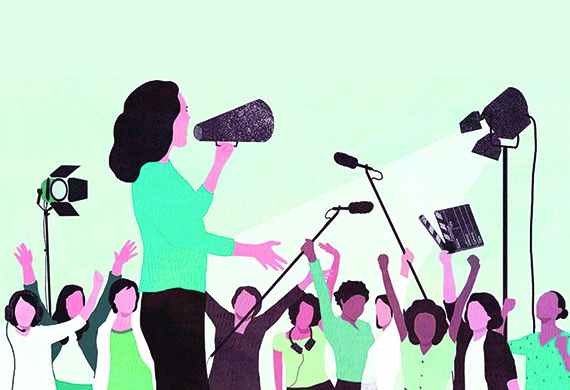
Only 10percent of Senior Leadership Positions in the Indian Media and Entertainment Sector are held by Women: Ormax Medi
By: WE Staff | Friday, 5 August 2022
According to the second edition of "O Womaniya!," a study on the representation of women in Indian films and the M&E industry, women held a pitiful 10% share in senior leadership positions in media and entertainment corporate houses as well as across head of department (HOD) roles in Indian films in 2021.
Amazon Prime Video provided help for the study conducted by the media consulting firm Ormax Media and the online video service Film Companion.
The report looked at how women were portrayed and represented in three key areas: content (which covered both on-screen and behind-the-scenes female representation), marketing (which looked at female representation in movie and television trailers), and corporate (which looked at female representation in boardrooms of the top 25 media and entertainment companies).
Five roles total—direction, writing, cinematography, editing, and production design—were examined for the report as HOD positions in the film industry.
In all, 100 movies and 50 TV shows from eight Indian languages—Hindi, Telugu, Tamil, Malayalam, Kannada, Punjabi, Bengali, and Gujarati—were released in 2021.
According to the survey, not a single woman directed or edited any of the 56 theatrical movies that were analysed across languages. Only 10% of senior leadership positions were held by women, even in media and entertainment corporations that are at the centre of decision-making, which had a ripple impact on inclusivity throughout the production and execution chain.
“While it’s no surprise that female representation in mainstream entertainment is low, the degree of skew, such as 10:90 on some key parameters, should be a wake-up call,” said Shailesh Kapoor, founder & CEO, Ormax Media. “While streaming titles, especially series, are more women-inclusive in on and off-screen representation, theatrical films continue to perform very poorly, and in fact, have shown no positive growth at all since the previous report, which covered content released in 2019 && 2020. We hope that this report serves as a starting point for the industry to come together and discuss ways to address the evident imbalance.”
Data are crucial for comprehending how radically skewed the gender equation in the Indian film business is, according to Anupama Chopra, a reviewer for films and the creator of Film Companion. “O Womaniya! provides us with the starting point for discussion and debate. Starting out as an effort by Ormax Media and Film Companion, the initiative has now found resonance with the entire industry. The support that we have received from film bodies, streaming services and studios is heartening. We will continue to build this momentum and hopefully lead the way to change,” she said.
The most fundamental "Bechdel Test," an internationally recognised indicator of female representation in film, was not passed by more over half of the theatrical releases.
A movie must contain at least one moment in it where two named female characters are speaking about something other than a man or men in order for it to pass the Bechdel Test.
Men speak more than women by a rate of 3:1, even in trailers. Women chatted for no more than 10 seconds in as many as 48 trailers on different estates.
“While there have been improvements in female representation in Indian entertainment, there hasn’t been any data-backed report in India that can hold a mirror up to the current reality. O Womaniya! 2022 fills the much-needed gap with its rich insights,” said Aparna Purohit, Head of India Originals, Prime Video. “The report serves as a good starting point to initiate discussions on the need to involve more women, particularly in decision-making roles, as that has a ripple effect on inclusivity in the entire ecosystem.”
Purohit noted that streaming services have undoubtedly created a more inclusive storytelling environment, giving women more possibilities and giving them a voice, which has led to an increase in stories with female protagonists.
Interestingly, when a woman approved a TV show or a movie, the proportion of female HODs doubled. In a similar vein, if a woman was responsible for commissioning the title, a higher percentage of films (68 percent) passed the Bechdel Test, and women had a higher percentage of trailer speak time (35 percent).
Most Viewed
- 1 Women's Health Startup HerMD Closing Doors Amid Industry Challenges
- 2 5 Famous Women in Indian Armed Forces
- 3 Saudi Women No longer Require Male Permission for Clothing Choices, says Prince MbS
- 4 Kolkata Medtech Startup Innovodigm Raises Rs 5.5 Crore Seed Funding Led by IAN Group
- 5 Yamunanagar's Kashish Kalra Honoured after Securing 111th Rank in UPSC Civil Services Exam
- 6 Madurai Appoints Its First Woman Corporation Head
- 7 IAS Vijayalakshmi Bidari Appointed as the new Nagpur Divisional Commissioner
- 8 American Entrepreneur Lucy Guo Overtakes T Swift to become Youngest Female Billionaire
- 9 ICC Women's World Cup 2025 Trophy Showcased at Indore's Holkar Stadium
- 10 Aparna Saxena's Beauty Venture AntiNorm Launches in India
- 11 Vidya Nataraj Co-Founded BlueStone Jewellery & Lifestyle files IPO
- 12 5 Women Freedom Fighters of India
- 13 Dr. G Krishnapriya appointed as CEO for Trichy
- 14 M3M & Sirona Partner to Introduce Menstrual Hygiene Vending Machines in 15 Locations
- 15 Punjab Govt launches SHE Cohort 3.0 Supporting Tech-led Women Startups
- 16 Indian origin Lawyer, Sweena Pannu appointed as the US New Superior Court Judge
- 17 The Aurora Tech Award recognizes 4 Indian Women-led Startups
- 18 Kerala's Republic Day parade featured an all-female tableau
- 19 Manisha Kabbur Becomes Karnataka's First Woman International Karate Coach
- 20 Director K. S. Ravikumar's Daughter Maalica Ravikumar Launches Life Coaching Company 'Evergrowth Academy' for Women
- 21 Leezu's Raises Pre-Seed Funding to Accelerate Growth in Sexual Wellness Industry
- 22 Sattu: Super-easy summer drink for PCOS gut healing
- 23 Swathi Nelabhatla creates Sitha App, India's First Women-Exclusive Gig Platform
- 24 7 Timeless Female Kathak Dancers & their Iconic Legacies
- 25 Meet 7 Iconic Women Architects of Modern India & their Most Impactful Work
- 26 This Woman-led Insuretech Startup is Helping Bridge the Education Financing Gap in India
- 27 Women Leaders Share Lessons Learnt from India Women's WC Win
- 28 5 Enterprising Women Founders Powering Singapore's Tech & Innovation Landscape
- 29 4 Women. 4 Stories. One Vision for Smarter, Stronger Healthcare
- 30 Global Gender Gap Narrows to 68.8%, But Full Equality 123 Years Away: WEF Report 2025
- 31 Changemakers: 7 Women Entrepreneurs Taking the Make in India Movement Forward
- 32 Meet Lucy Guo, The Youngest Self-Made Female Billionaire Disrupting Tech
- 33 How Women are Driving India's Festive Online Shopping Surge






